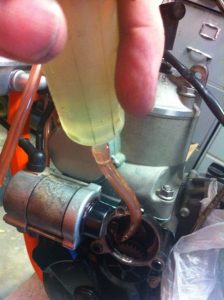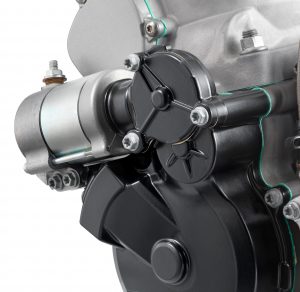Some two-stroke electric-start systems have been wearing out prematurely, forcing riders to switch back to the reliable old boot. It’s not that hard to see why.
Two-stroke starter motor gears run dry off the flywheel magneto, with no lubrication apart from a small amount of grease when they are assembled. The majority of four-stroke starters get help from the engine oil because they run off an alternator which is soaked in the stuff.
It was difficult for the European manufacturers to add a starter motor to their two strokes without a total engine redesign. If you have a look at the engine architecture you’ll see that there is very little room to position a starter motor behind the cylinder, because of the carburettor and reed valve, or in front because of the exhaust and power valve.
KTM’s solution was to fit the starter motor on the side of the engine horizontally above the flywheel magneto. This solution was also used on Kato’s Husaberg and Husqvarna models.
Spain’s Gas Gas went for a 45-degree angle on the starter motor while Beta and Sherco bit the bullet and redesigned their crankcases to put the starter motors out of harm’s way under the engine but still running “dry” off the flywheel magneto. The latter two designs can run straight-cut gears and do not appear to be having problems.
KTM has redesigned the starter motor set-up for the recently revealed 2017 models. But for current KTM owners with the old system the answer to the problem is to, as KTM recommends, not use the button when the bike is cold but kick start it to prevent undo stress on the starter and battery and then just use it to restart during enduro competition or stuck on hills.
MAKE IT LAST
Here is a trick I learned to make the 2T starter motor last as long as possible:
Step 1 Block the vent hole in the bottom of the flywheel cover with high-temperature silicone to keep out crud.
Step 2 Drill a small hole in the rubber grommet at the top of the cover through which the stator wires run and glue a rubber breather hose into that grommet.
Step 3 Run the breather hose up under the fuel tank, secure it with cable ties and out of the way of any dirt and water.
Step 4 Remove the starter gear inspection cover and fill with 150mm of automatic transmission fluid or five weight fork oil before refitting.
This fluid will lubricate the starter motor gears and prevent them from wearing out prematurely.

